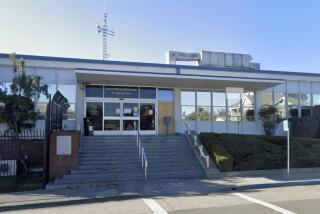Blue Lights Keep Memories Alive
- Share via
Two years ago, Cathy Beyea began putting a blue Christmas light in her window to commemorate her son, a rookie Los Angeles police officer shot in the head with his own gun by a teenage burglar.
In doing so, she joined thousands of people nationwide who string up blue lights this time of year as a tribute to law enforcement officers killed in the line of duty.
“I think it’s a great way to show support for the police, especially in L.A.” said Beyea, of Santa Clarita, whose son was 24 when he was killed. “For the past few years they’ve been getting kind of a bad rap.”
Project Blue Light, as it is called, began in 1988 when the mother-in-law of a slain Pennsylvania police officer placed a single blue bulb in the front window of her home.
“It took off from there,” said Terrie Soper, spokeswoman for Concerns of Police Survivors, a national nonprofit group formed in 1984 to assist the families of slain officers.
The group is leading a national campaign to spread the blue light custom, which has been slower to take hold in Southern California than in the rest of the United States.
Richard Sherman, a clinical psychologist who lectures at Cal State Northridge, compared blue lights to the yellow ribbons posted by the families of soldiers during wartime.
“Whether it’s a blue light or a yellow ribbon, it provides a sense of bonding,” Sherman said. “It’s not only for those who are suffering a loss, but it allows others to show caring, support and respect. It’s really a pulling together.”
In New Jersey, more than 800 blue bulbs adorn a pine tree in front of a house where a state trooper lived before he was fatally shot during a traffic stop in 1981, three days before Christmas.
Blue lights adorn the Christmas tree of a Massachusetts woman who learned she was pregnant one week after she buried her husband, an officer shot in 1985.
A Florida man whose son was killed, allegedly by a drifter, now outlines his home in blue lights during the holidays. He encourages others to do the same, spreading the word in Christmas cards.
Project Blue Light is growing not only as a tribute to slain officers but as a show of support for those who wear the badge.
Concerns of Police Survivors has been sending fliers and faxes to police departments nationwide.
“I’m sure there are a lot of folks out there who maybe haven’t heard of it, but would love to participate,” said Dennis Zine, vice president of the Los Angeles Police Protective League. “A lot of people won’t pick up the phone or write a letter. But this is free and it’s easy, and it’s a genuine symbol for a pat on the back for doing a job that many people don’t wish to do.”
Police work consistently ranks among the most dangerous occupations, according to statistics kept by the national Occupational Safety and Health Administration. Concerns of Police Survivors has tallied 1,949 officers killed in the United States in the line of duty since 1985, including 147 this year.
For the past three years, California has led the nation in the number of law enforcement officers killed in the line of duty, and is in that position again this year, according to government statistics. Since 1990, 107 officers in the state have been killed on the job.
Beyea, the mother of the slain LAPD officer, surmises that Project Blue Light is not well known in Southern California because the survivors’ advocacy group does not have an active local chapter.
“Never heard of it,” said Kenneth Brondell, a retired LAPD detective, whose daughter, Christy Lynne Hamilton, was killed in 1994 by a sniper, a week after she graduated from the LAPD Academy.
Hamilton’s brother, Kenneth Brondell Jr., said after hearing of the program: “I think I’ll put up some lights this weekend.”
Debra Glaser, an LAPD psychologist, said the project is an excellent way to boost morale.
“Police tend to deal with people when they’re in trouble, when there isn’t much positive interaction going on,” Glaser said. “This is a very simple way to initiate positive contact. An officer can be driving down the street, look up at one of these blue lights, and feel that somebody appreciates what they are doing.”
Soper, the Concerns of Police Survivors spokeswoman, said she does not see a conflict with the tradition of displaying blue and white lights during Hanukkah.
Project Blue Light seeks to evoke positive feelings toward police officers, but the lights also mark individual tragedies.
Tim Littlefield, a sergeant with the San Bernardino Police Department, left behind five children when he was killed 11 years ago in his police cruiser by a driver who ran a red light.
His widow, Barbara McMurrich, decorates her Highland home with blue lights during the holidays and keeps a blue candle in the living room.
“Sometimes if they’re thinking about their dad, the kids will go in and light that candle,” said McMurrich, who has since remarried.
Cameron Burt, 15 months old, has never met his father, and never will.
He was not born when his father, Don Burt, a rookie California Highway Patrol officer stationed in Santa Ana, was shot to death during a traffic stop July 13, 1996.
This year, the boy’s grandparents, Don and Jeannie Burt, plan to outline their Perris home in blue lights in memory of their son.
Because of the danger of the job, police officers and their families never know what to expect from one shift to the next.
Donna Lamonaco and her children were at home baking Christmas cookies in 1981 when her husband, a New Jersey state trooper, was shot to death.
She recalled how two of Philip Lamonaco’s fellow troopers came to her door. It was three days before Christmas.
“I didn’t think anything of it,” said Lamonaco, 47. “I told them Phil would be home in a few minutes. Then one of them took the baby out of my arms and told me to sit down. They said Phil had been hit. I asked him if it was by a truck or car. They said he was shot. . . . When I got to the hospital, he was already gone.”
For Lamonaco and her children, the youngest now 16, many aspects of the Christmas season have been ruined.
“We can just never make Christmas cookies again. Ever,” she said.
Struggling to find new ways to celebrate the season, the family three years ago began decorating a large pine tree in their frontyard with blue lights, 800 of them.
“It’s been 16 years now,” said Lamonaco, a clerk in the Hunterdon County prosecutors office. “The lights make people come and ask questions. It makes me feel good to tell them what they’re about.”
They mean, “Don’t forget,” she said. “Please don’t ever forget.”
More to Read
Sign up for Essential California
The most important California stories and recommendations in your inbox every morning.
You may occasionally receive promotional content from the Los Angeles Times.














